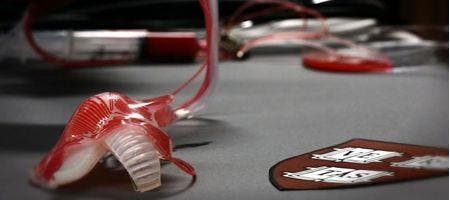After UAVs inspired by hawks, robotic stability control spun from leaping lizards, wall climbing derived from geckos or the swimming artificial jellyfish made from rat cells, in yet another remarkable feat of robotics which draws inspiration from nature scientists at Harvard University have created a robot which mixes the blending capabilities of a squid with the locomotion mechanics of a sea creature.
“We began with the fundamental science question of, ‘Can we make a soft-bodied robot in a very primitive way?’ ” says George Whitesides of Harvard, co-author of the new study in Science this week.
The robot employs a dynamic coloring system, based on micro-channels into which dye is being pumped. These color layers used for the camouflage were first created using molds from 3D printers. Silicone is then poured into the molds to create these micro-channels, topped with another layer of silicone. In all, it takes 30 seconds for the robot to fill with color and another 30 seconds for it to drain – a full minute to completely blend into its surroundings or, oppositely, stand out.
“When we began working on soft robots, we were inspired by soft organisms, including octopi and squid,” says post-doctoral fellow Stephen Morin.
“One of the fascinating characteristics of these animals is their ability to control their appearance, and that inspired us to take this idea further and explore dynamic coloration. I think the important thing we’ve shown in this paper is that even when using simple systems – in this case we have simple, open-ended micro-channels – you can achieve a great deal in terms of your ability to camouflage an object, or to display where an object is.”
Applications for the robot, according to the researchers, include surgical simulation, planning, and training. In medical training today, most practice is made on real tissue, however a disposable artificial tissue which can mold and change color according to the organ or tissue it needs to simulate might aid in efforts. Also, when filled with florescent dye, the robot becomes distinctly visible acting as a visual marker for search crews following a disaster. The same micro-channels are pumped in or out with air to allow for locomotion, much similar to how a starfish moves in the ocean.
Also, the squishy robot’s camouflage capabilities aren’t limited to visible spectrum. It can change its temperature and thus become invisible to infrared as well, or again stand out for infrared scanners. Or one could hide an object in the visible spectrum and illuminate it in infrared.
“What we hope is that this work can inspire other researchers to think about these problems and approach them from different angles,” Morin says.
“There are many biologists who are studying animal behavior as it relates to camouflage, and they use different models to do that. We think something like this might enable them to explore new questions, and that will be valuable.”



